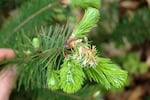
Characteristic sudden oak death shoot blight symptoms on emerging shoot and needles of a Douglas fir.
Alan Kanaskie, Oregon Department of Forestry.
For the first time, scientists have found a deadly plant disease infecting fir trees in the Pacific Northwest.
The so-called “European” strain of sudden oak death showed up in southwest Oregon a few years back. It was known to spread to fir trees in Europe, but that hadn’t been seen in the state.
Related: A Disease That’s Felled Forests in California and Oregon Shows up in Washington
The European strain is different from the North American strain of sudden oak death. The latter has been killing tanoak throughout Curry County for years, but the European strain has forest managers particularly worried – because of its potential to infect the commercial timber base.
It's now the subject of a new study published in the journal, Plant Disease.
“This report shows that it is able to infect Douglas fir and grand fir. And it’s doing it in the forest,” said Oregon State University forest pathologist Jared LeBoldus, lead author of the study.
Sudden oak death showed up in Douglas and grand fir saplings growing under an infected tanoak tree. The trees had wilted tips, needle loss and discoloration.
Related: Deadly Plant Disease Confirmed For First Time In Pacific Northwest Fir Trees
“The main concern would be that the infections are on the new growing points. So if all those parts are killed, the tree isn’t necessarily be able to grow in its normal way it would if it’s not infected,” LeBoldus said.
LeBoldus stresses that scientists have yet to see a fir tree die of sudden oak death. It’s believed to take a couple years for a tree to die of the disease.
The European strain of sudden oak death first appeared in a Curry County, Oregon, nursery in 2012. It spread from an infected rhododendron to tanaok in the surrounding forest.
State and federal agencies have been focusing funding on eradicating the new strain, which is still relatively geographically contained near the Pistol River. They’re using fire to destroy host material in the forest.
“We believe that it is more aggressive. It’s appears to be behaving that way, even though we have not seen major impacts to conifer species. It’s worth being cautious and try to treat those as thoroughly as we can,” said Ellen Michaels Goheen, a pathologist for the U.S. Forest Service.
